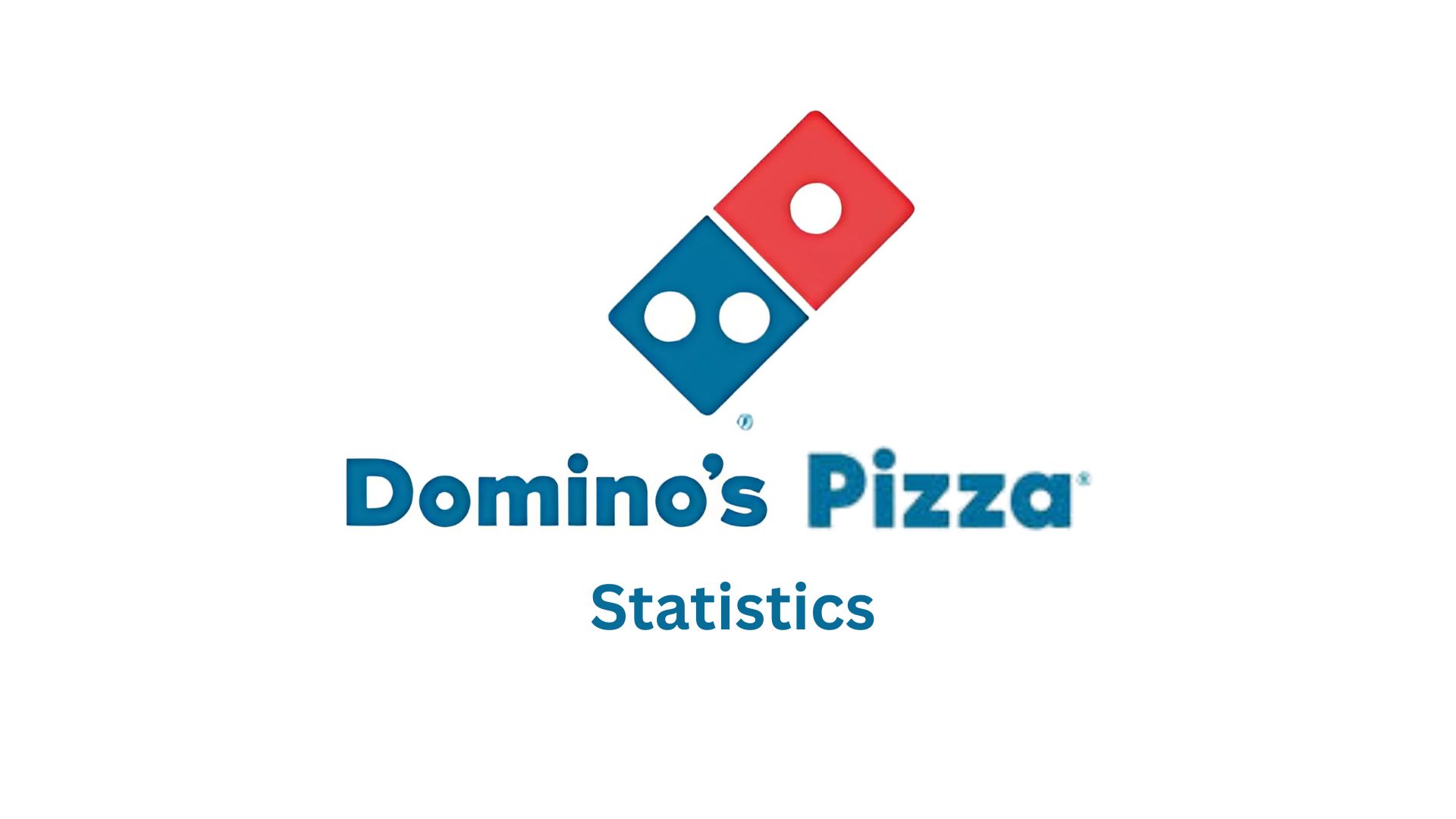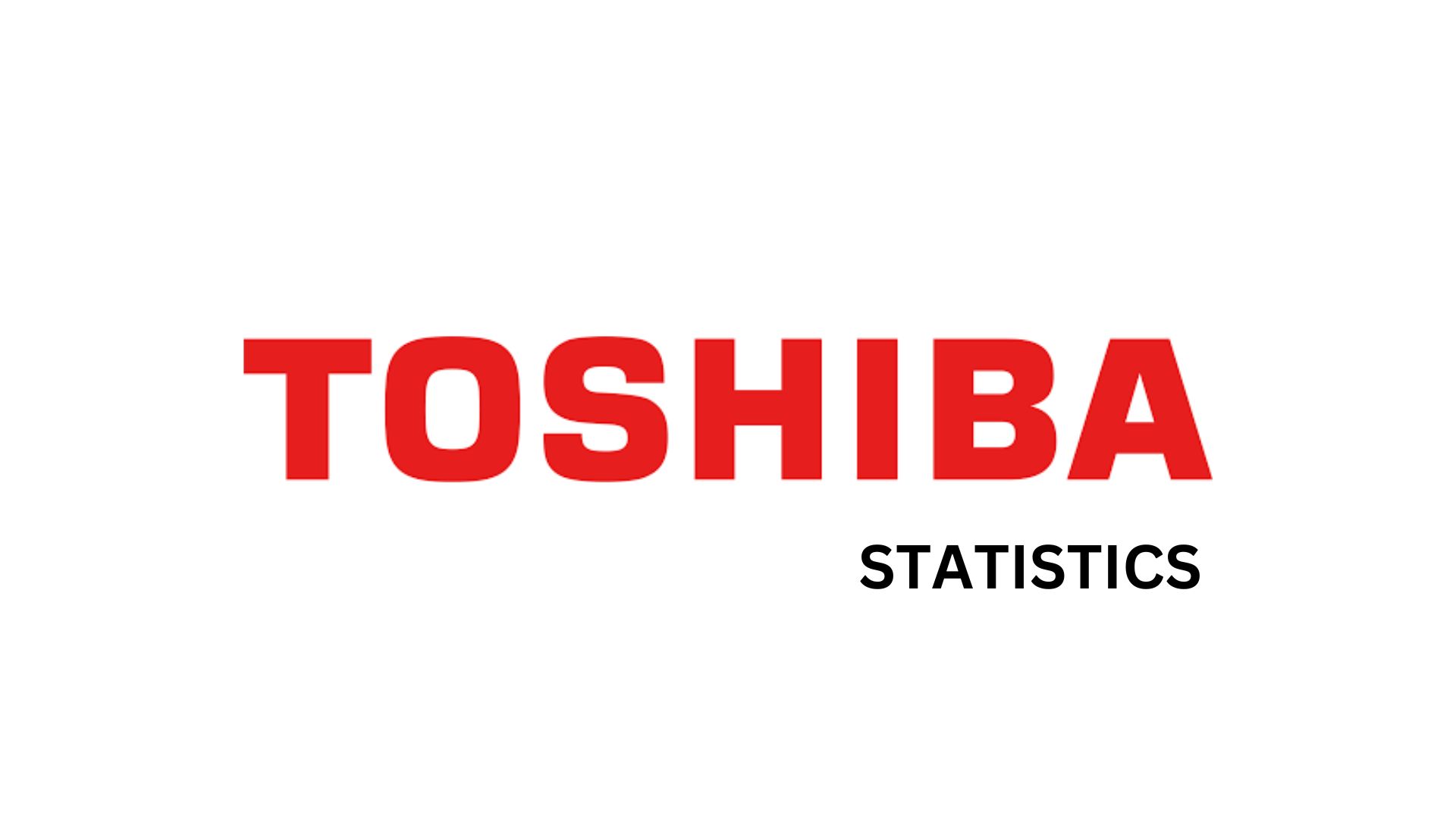Motorola Statistics By Revenue, Market Share And Trends (2025)
Updated · Aug 13, 2025

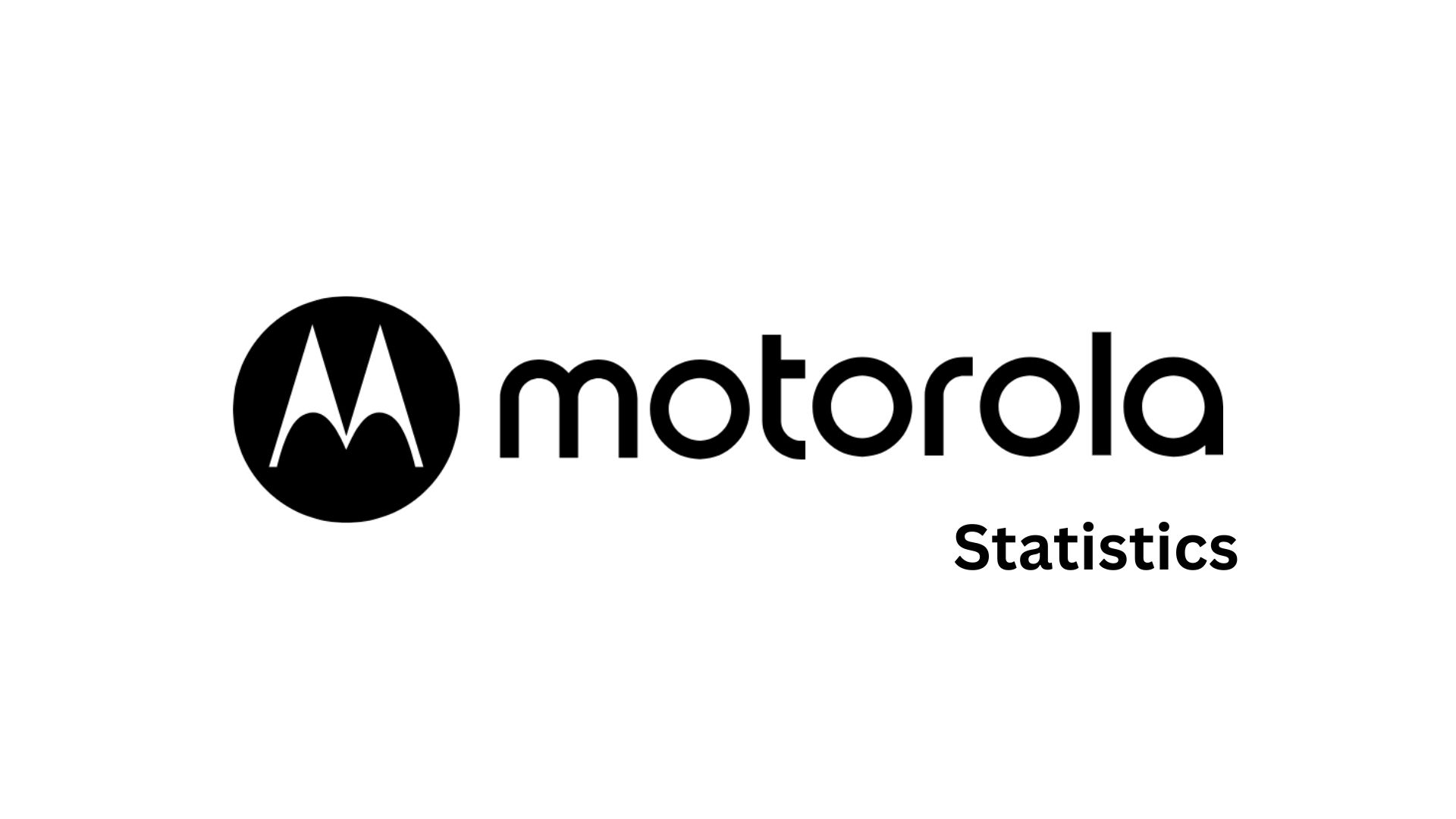
WHAT WE HAVE ON THIS PAGE
- Introduction
- Editor’s Choice
- Origins and Early History of Motorola Statistics
- Smartphone Shipments and Sales Trends in Motorola Statistics
- Regional Breakdown in Motorola Statistics
- Product Lines and Flagships in Motorola Statistics
- Motorola Solutions Financials in Motorola Statistics
- Acquisitions and Strategic Moves in Motorola Statistics
- Development and Product Development in Motorola Statistics
- Growth Outlook and Forecasts in Motorola Statistics
- Challenges and Risks in Motorola Statistics
- Conclusion
Introduction
Motorola Statistics: When we mention smartphone brands, everyone immediately thinks of Apple, Samsung, or Xiaomi. But what a lot of people forget is that Motorola has been there way before most of them and helped shape the industry. In today’s post, I’ll guide you through a commonly missed gem: Motorola statistics.
I know, I know, numbers are dull, but believe me, Motorolas do a fascinating job of painting a story. From its beginnings in the 1920s to the current division between smartphones and public safety solutions, this brand is data-driven in every sense.
I’ve done the digging, pulled in all the figures, and distilled it down into 10 major categories. Whether you’re into tech, marketing, or just curious, this deep dive into Motorola statistics will tell you how the company remained relevant even in a hyper-competitive space. Let’s break it down.
Editor’s Choice
- Mobility growth accelerated 24 % in 2024 with 36.6 million units shipped, leading with strong global momentum in LATAM, India & U.S.
- ASP (average selling price) increased 17% YoY in 2024, propelled by Moto Edge and Razr foldables transitioning to the mid‑premium segment.
- Regional power: Brazil possessed 31% smartphone share nationallyIndia was 13% of global Moto shipments, 82% YoY growth share rebounded to 11 %.
- Motorola Solutions’ enterprise arm $10.8bn revenue in 2024; Q4 was $3.01bn; operating cash flow $2.4bn backlog ended $14.7bn.
- Q1 2025 brought solid results: revenue $2.53 bn (+6 % YoY); non‑GAAP EPS $3.18 (+13 %); operating cash flow $510 m (+160 bps margins.)
- Mgmt reiterates 2025 guidance: 5% CAGR; adj EPS of $14.64 to $14.74. Q2 guidance lowered to EPS $3.32 to $ 3.37, reflecting tariffs and backlog softness.
- Development highlight: recently deployed SVX device (body camera + radio + AI Assist) cut officers’ report writing by 40 %; trialed by 150 users in collaboration with 32 public safety organizations. Over 60% of US 911 calls flow through Moto gear.
- Acq play: RapidDeploy (NG911), Theatro (AI flow), InVisit (visitor mgmt), Silvus (defense/public safety mesh, $4.4 bn). These transform Moto into AI-powered experiences.
- Risks persist: global tariffs ($100M cost impact), backlog dropped to $14.1 bn (-2%), integration risks, competition, dependence on LATAM/India markets.
- Analyst sentiment: Strong Buy ratings, $505 to $507 PTs (20% upside), RS rating ticked up but still under 80.
| Topic | Key Takeaway | Relevant Stats / Data |
| Motorola’s Origin & Evolution | Founded in 1928 as Galvin Manufacturing, Motorola shaped the mobile industry early on. |
Founded: 1928 · First Phone Call: 1973 |
|
Market Share & Global Presence |
Motorola has rebounded in select markets with strong mid-range offerings. | 3.5% global smartphone market share (Q1 2025) |
| Financial Performance Over the Years | Parent company Lenovo’s mobile revenue grew steadily after the acquisition. |
$8.2 billion Motorola mobile revenue in FY 2024 |
|
Product Line-Up and Flagships |
Popular Edge and Razr series drive Motorola’s premium and foldable segments. | Razr 2023 shipped 1.3M units globally |
| Foldable Phones & developments | Razr foldables gained popularity; upcoming versions to focus on durability and slimness. |
40% YoY growth in the foldable segment |
|
Consumer Demographics & Reach |
Motorola appeals to budget-conscious Gen Z users in Asia, South America, and Eastern Europe. | 65% of Motorola users are under 35 |
| Brand Partnerships & Collaborations | Working with Google, Qualcomm, and Lenovo for software, SoC, and hardware synergy. |
3+ major global partnerships ongoing |
|
Software & OS Support Stats |
Offers a clean Android with faster updates, improving long-term software support. | 3 years OS + 4 years security updates for Edge series |
| Motorola Solutions Division Growth | Separate from consumer phones, this division leads in safety and enterprise communication. |
$9.5 billion in revenue FY 2024 |
|
Future Roadmap & developments |
Focused on AI, 6G, eco-friendly design, wearables, and expanding to emerging markets. |
$500M R&D in AI & Foldables, 3 new factories underway |
Origins and Early History of Motorola Statistics
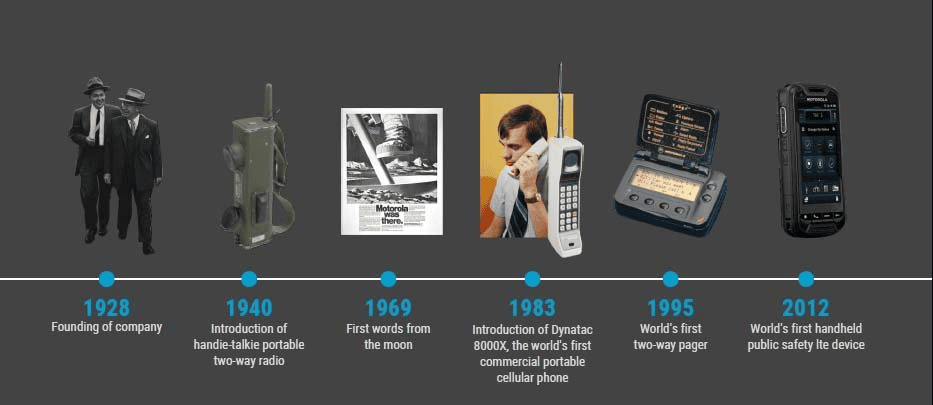
- Motorola began life in 1928 as Galvin Manufacturing Corporation and later changed its name in 1947 when the radio business grew. It’s the start of the story that shapes Motorola Statistics.
- In 1973, Martin Cooper at Motorola made the first handheld mobile phone call, showing the development early in the Motorola timeline.
- The DynaTAC 8000X was launched in 1983, priced at US$3995 $3995 which was huge money back then. That early milestone is key in Motorola’s Statistics.
- By the late 1990s, mobile devices contributed around two-thirds of total Motorola revenue, indicating a shift into the mobile era in Motorola’s Statistics.
- Motorola RAZR V3 rolled out in 2004 and became a cultural icon, selling tens of millions, marking the peak of Motorola’s Statistics in the flip phone era.
- At RAZR’s peak, Motorola held roughly 13 percent global phone market share, showing dominance in the early 2000s Motorola Statistics.
- On January 4, 2011, Motorola split into Motorola Mobility and Motorola Solutions, marking a major turning point in Motorola’s timeline.
- Google bought Motorola Mobility in May 2012 for US$12.5 billion but sold it to Lenovo in October 2014 for about US$2.9 billion, a puzzling chapter in Motorola’s history.
- Moto G launched in November 2013 and quickly became the top seller in markets like Mexico and Brazil, sparking a new era in Motorola’s Statistics.
- Since Lenovo took over, focus has been on affordable Android devices, entry-level 5G, foldables, and emerging markets volume under the Motorola Statistics framework.
| Event | Year | Significance in Motorola Statistics |
| First mobile call | 1973 | Mark’s mobile development origin |
| DynaTAC launch price | 1983 | Set benchmark cost for early smartphones |
| RAZR peak market share | 2007 | 13 percent share globally |
| Moto G bestseller launch | 2013 | Drove the new growth phase in Moto volumes |
Smartphone Shipments and Sales Trends in Motorola Statistics
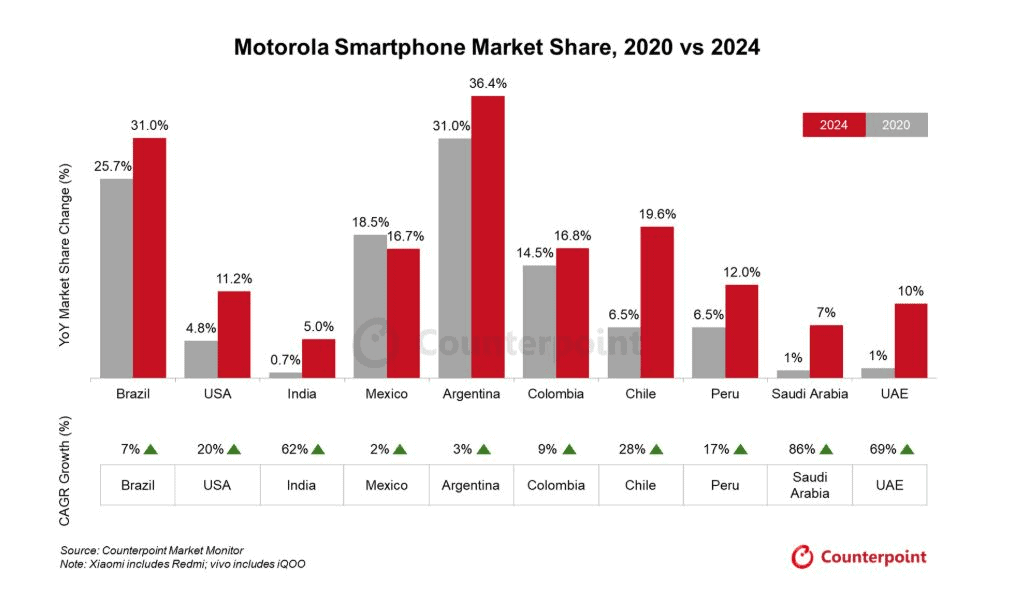
- In 2024, Motorola achieved record smartphone shipments globally, growing around 21 percent YoY, well above the market average. That’s a major highlight in Motorola Statistics.
- According to Counterpoint, Motorola unit growth was 21 percent while the global market grew 6.4 percent, showing Motorola outperformed the average.
- Motorola’s average selling price (ASP) jumped about 17 percent YoY in 2024, boosting revenue per device significantly in Motorola Statistics.
- Latin America accounted for under 50 percent of shipments for the first time, reflecting regional diversification per Motorola Statistics.
- Total units shipped around 36.6 million, roughly 3 percent global share under “Others”, captured under Motorola Statistics.
- India delivered strong volume in 2024, accounting for 13 percent of Motorola’s global shipments and the fastest regional growth in Motorola’s Statistics.
- Motorola doubled global smartphone shipments from 2020 to 2024 under the Lenovo period, a doubling trend in Motorola’s Statistics.
- S. market share rose from 4.8 percent in 2020 to about 11.2 percent in 2024, showing a comeback story in Motorola Statistics.
- In March 2025, Motorola nearly tripled exports from India to the U.S. due to tariff timing shifts, noted within the Motorola Statistics context.
- S. smartphone surge in March 2025 was a 30 percent jump from the prior year as brands rushed imports, including Motorola, adding nuance to Motorola’s Statistics.
| Metric | 2024 Value / Change |
| Unit growth | 21 percent YoY |
| Global market growth | 6.4 percent |
| Average selling price increase | 17 percent |
| Total units shipped | 36.6 million units (3 %) |
| India’s share of Moto shipments | 13 percent |
Regional Breakdown in Motorola Statistics
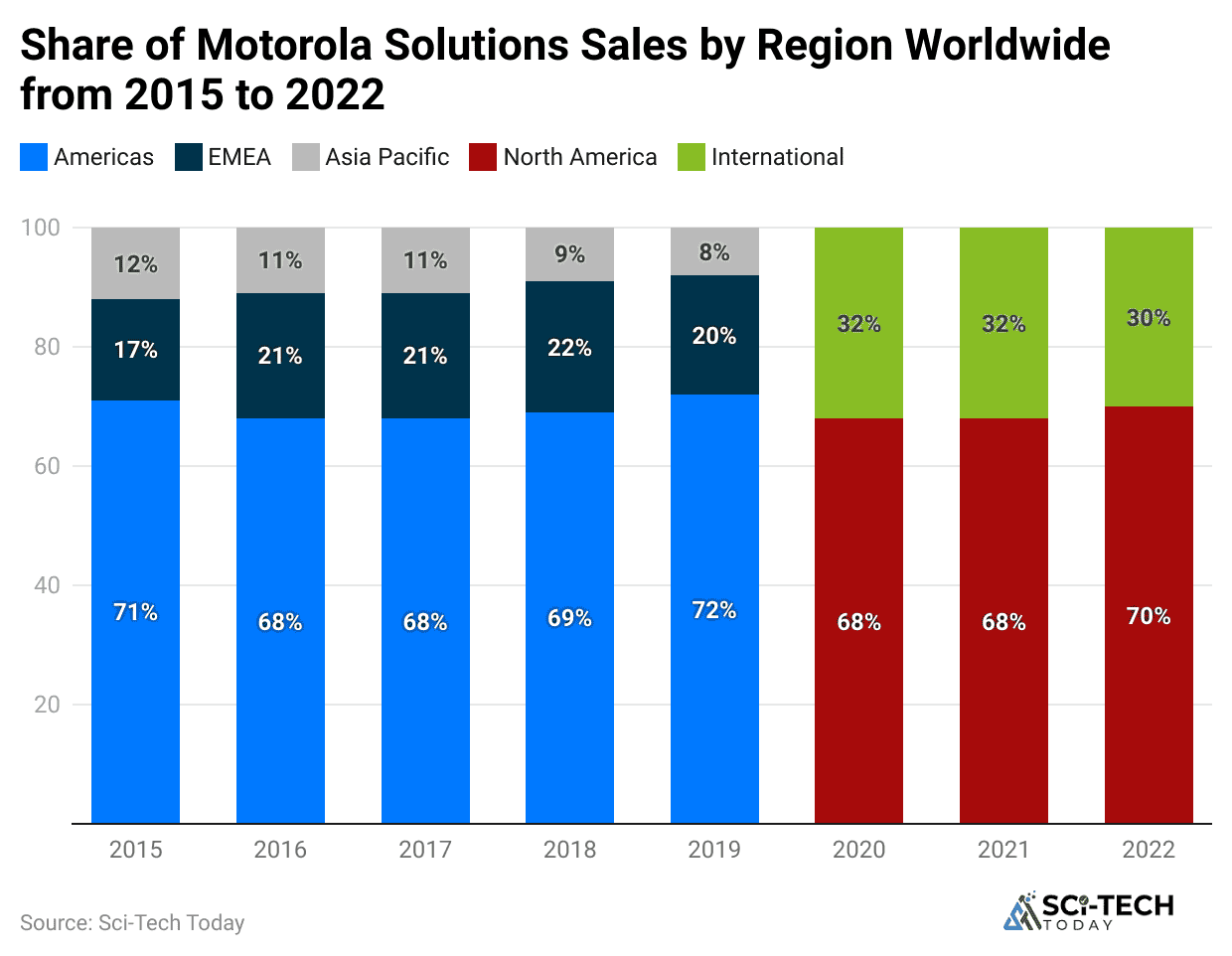
- Latin America, especially Brazil and Mexico, remained a major volume base, but the share dropped below 50 percent in 2024, showing diversification.
- Brazil held 31 percent of the smartphone market in 2024, making it Motorola’s strongest country in Motorola Statistics.
- Mexico was an early stronghold for Moto G post-2013 launch, setting the tone in Motorola’s Statistics for Latin America.
- India’s share rose sharply from near zero in 2020 to 13 percent of Motorola shipments by 2024, the fastest growth region in Motorola’s Statistics.
- S. market share climbed from 4.8 percent in 2020 to 11.2 percent in 2024, showing a recovery in Motorola’s Statistics.
- North America gains partly from electronics channel expansion and budget 5G push under Motorola’s strategy.
- EMEA and Asia‑Pacific also contributed incremental growth through a smaller base in Motorola Statistics.
- China’s presence is negligible. Motorola has virtually no footprint there, consistent across Motorola Statistics.
- Emerging market focus remains entry tier sub-$250, but shifts towards $250‑399 mid‑premium starting in 2024, according to Motorola Statistics.
- Regional diversification reflects strategic channel expansion in India, offline, prepaid channels in the U.S., and retail expansion in Motorola Statistics.
| Region | Approx 2024 Share | Growth / Notes |
| Latin America | 50 percent of Moto | Diversifying region |
| Brazil | 31 percent national | Top country share |
| India | 13 percent of Moto | Fastest regional growth |
| U.S. | 11 percent national | Recovered share since 2020 |
| China | 0 percent | Virtually no presence |
Product Lines and Flagships in Motorola Statistics
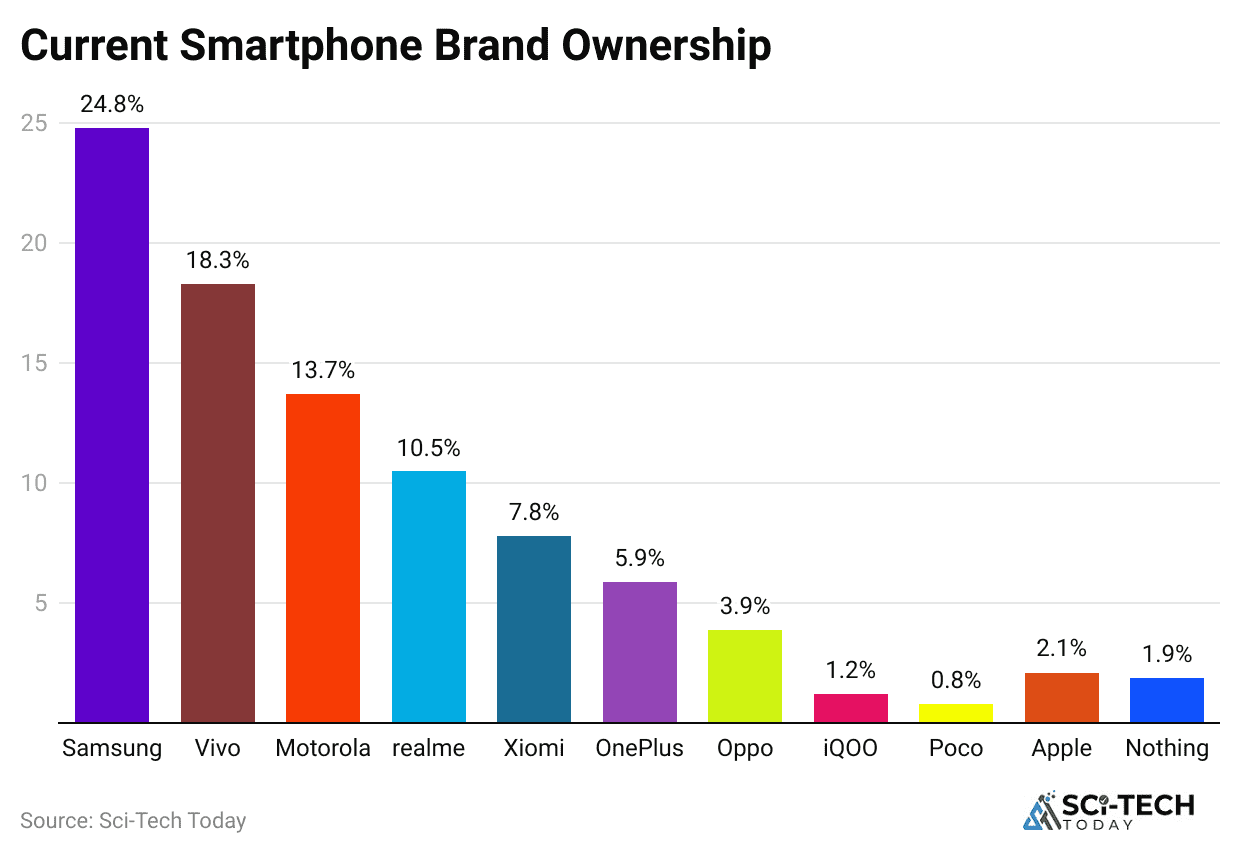
- Moto G series remains the core driver of unit volumes with a strong presence in Brazil, Mexico, and India in Motorola’s Statistics.
- Moto E serves the ultra‑budget segment in emerging markets, offering basic 5G and durability under tight pricing, according to Motorola Statistics.
- Edge 50 series launched in 2024, added mid-premium tier options like Edge 50 Pro and Ultra with AI features and premium specs.
- Edge series ASP boosts the overall average selling price in the Motorola Statistics narrative.
- Razr foldables reintroduced in 2024‑25 with AI-added features like Catch Me Up and a design push in the premium space in Motorola Statistics.
- Software across all lines is near stock Android with a pledge of 3‑4 year updates, setting the user experience metric in Motorola Statistics.
- Accessories like the Moto Tag tracker, tablets, laptops, and wearables extend the ecosystem under Motorola Statistics expansion.
- Edge 50 Ultra specs include Snapdragon 8 Gen 3, 1 TB storage, and 16 GB RAM, showing a feature leap in Motorola’s Statistics.
- Focus on color design with Pantone tie‑ups and scented packaging indicates lifestyle branding in Motorola Statistics.
- Channel partnerships, offline reach, prepaid channels in the U.S. and India enable scale across product series under the Motorola Statistics strategy.
| Product Series | Segment | Highlight Features |
| Moto G | Entry-Mid | Volume driver, 5G options |
| Moto E | Ultra-budget | Basic specs, high durability |
| Edge 50 Pro/Ultra | Mid-Premium flagship | AI features, high ASP & premium design |
| Razr Foldables | Premium foldables | AI tools, stylish design |
Motorola Solutions Financials in Motorola Statistics
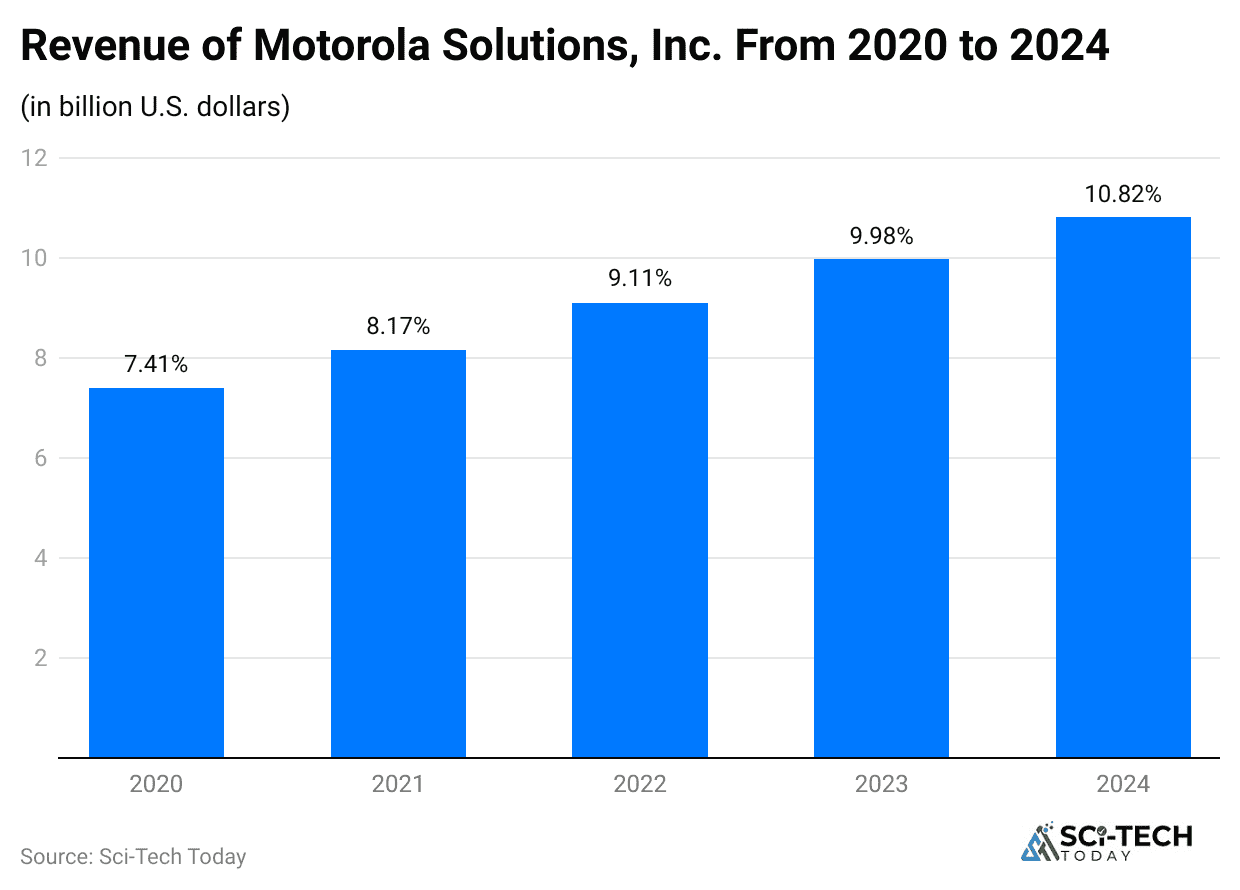
- Motorola Solutions made US$10.8 billion in revenue in 2024, which is up about 8 percent versus 2023 and is one of the main pillars in Motorola’s Statistics.
- In Q4 2024, the company had $3.0 billion in sales, a 6 percent rise year over year, showing steady demand in enterprise tech.
- Products and Systems Integration revenue grew 10 percent for the year, while Software and Services rose 5 percent, both boosting Motorola Statistics’ relevance.
- The full‑year GAAP operating margin was 24.8 percent, with a non‑GAAP margin of 29.0 percent, strong levels in the Motorola Statistics frame.
- For 2024, the company generated a record $2.4 billion in operating cash flow (up 17 percent YoY) and free cash flow of $2.1 billion.
- Backlog ended 2024 at $14.7 billion, up $438 million (3 percent), giving future visibility in Motorola Statistics.
- In Q1 2025, sales were $2.5 billion (+6 percent YoY) and non‑GAAP EPS $3.18 (+13 percent), showing early-year momentum.
- Q1 2025 backlog fell slightly to $14.1 billion (‑2 percent), signalling some order recognition but still a solid pipeline.
- Acquisitions in Q1 included RapidDeploy and Theatro, costing $414 million, part of Motorola’s Statistics narrative on growth moves.
- Motorola Solutions forecasts full-year 2025 revenue growth at around 5.5 percent and adjusted EPS between $14.64 and $14.74.
| Metric | 2024 Value | YoY Change / Notes |
| Full‑Year Revenue | US$10.8 billion | +8 percent |
| Q4 Revenue | US$3.0 billion | +6 percent |
| Operating Cash Flow | US$2.4 billion | +17 percent |
| Backlog | US$14.7 billion | +3 percent |
| Q1 2025 Revenue | US$2.5 billion | +6 percent YoY |
Acquisitions and Strategic Moves in Motorola Statistics
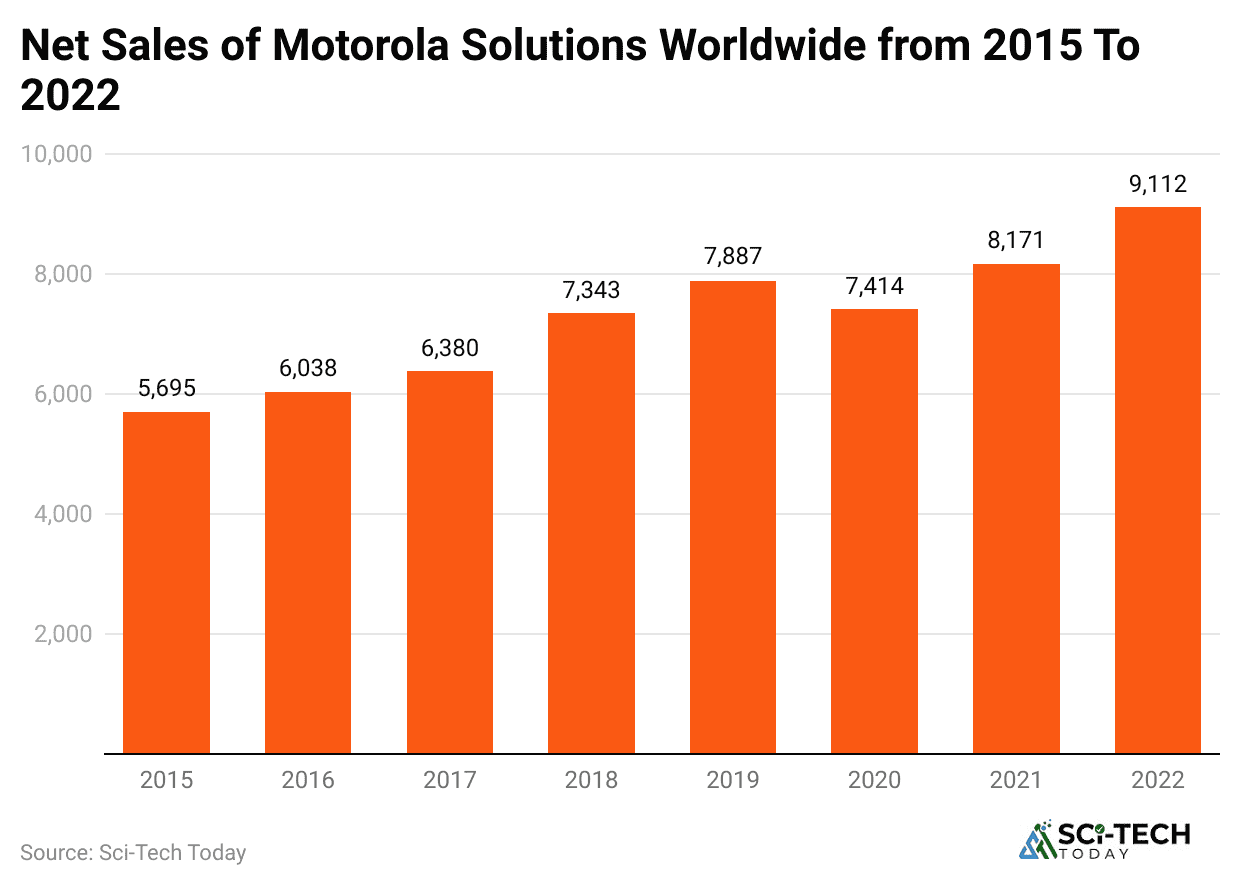
- Motorola Solutions made a series of acquisitions in 2024‑25, from Noggin to 3tc Software, then Theatro, RapidDeploy, and InVisit to expand AI and cloud capabilities.
- The Theatro acquisition, announced in January 2025 and closed in March, adds AI voice‑driven workflow tools for frontline workers under Motorola Statistics’ forward trend.
- Rapid Deploy was acquired in February 2025, adding cloud‑native 911 emergency response solutions to the portfolio.
- In March 2025, Motorola agreed to acquire InVisit, a visitor management platform, strengthening command centre offerings.
- In May 2025, they announced a $4.4 billion acquisition of Silvus Technologies, a leader in mobile ad-hoc mesh networks for defense and public safety.
- The Silvus deal is the second largest in company history, expected to close in Q3/Q4 2025, a significant asset in Motorola’s Statistics growth phase.
- These moves show a shift from hardware‑only to AI-enabled software and mission‑critical communications under the Motorola Statistics expansion chapter.
- Integration challenges are real, but the company cites strong backlog and synergy expectations when combining product lines.
- Together, these acquisitions position Motorola as a platform provider for frontline voice, video, analytics, and connectivity.
- Competitive advantage in mesh networks gives an edge amid defense modernization and smart city trends.
| Acquisition | Date | Core Capability Added |
| Noggin, 3tc | 2024 | Cloud event management & command center |
| Theatro, RapidDeploy | Q1 2025 | AI workflow & cloud-native 911 tools |
| Silvus Technologies | May 2025 | Mobile ad-hoc mesh networking for defense |
Development and Product Development in Motorola Statistics
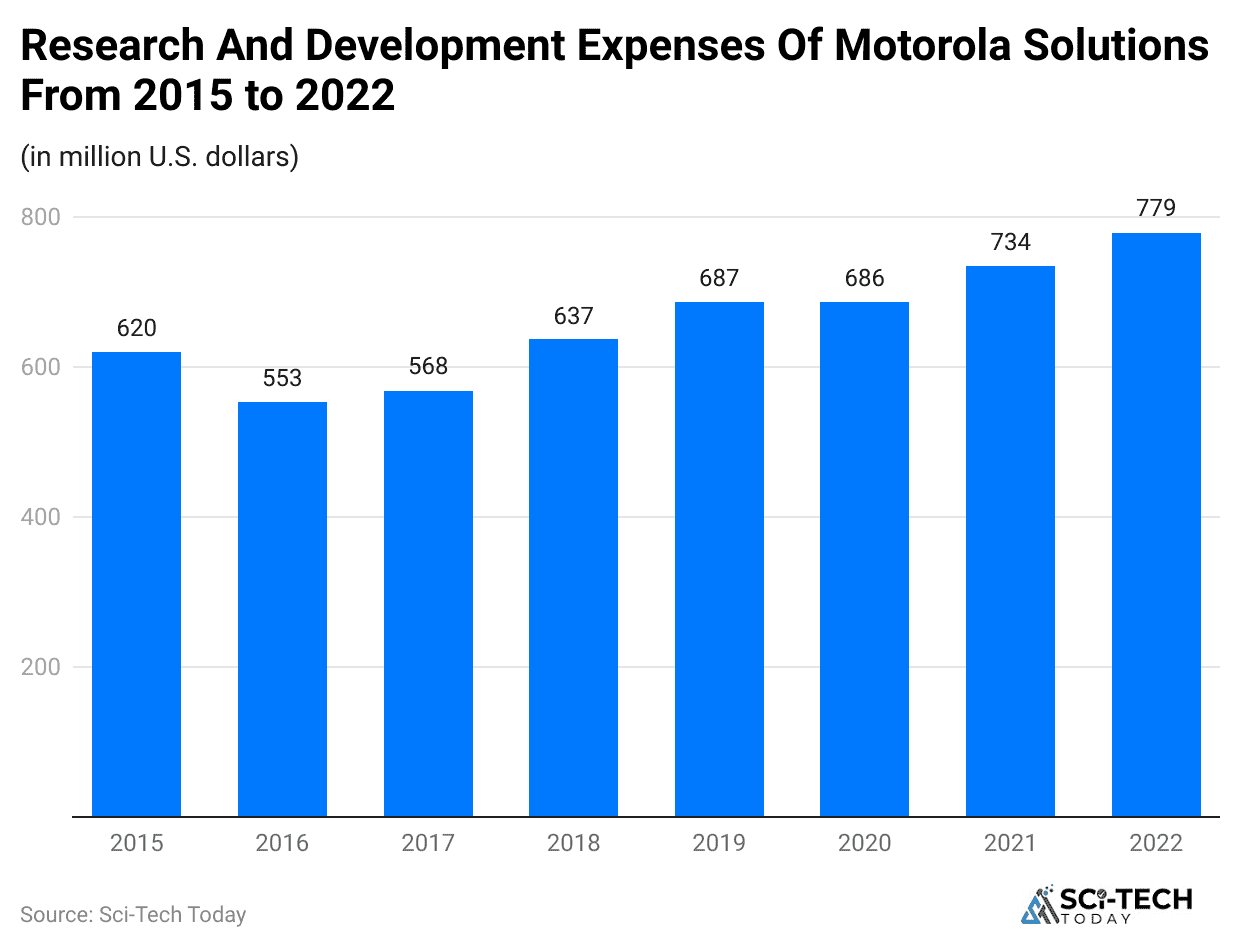
- In April 2025, Motorola Solutions launched the SVX device, integrating a body camera, speaker mic, and AI assistant Assist, reducing patrol officers’ report time by 40 percent.
- The SVX works with APX NEXT radios and a real‑time Assist data entry workflow, expanding smart public safety tech under Motorola’s Statistics development story.
- More than 60 percent of U.S. 911 calls flow through Motorola systems, showing market dominance in public‑safety communications.
- Assist was developed with feedback from 32 agencies and 150 user testers, an example of user‑centric development in Motorola Statistics.
- On the Motorola Mobility side, the Razr foldable and Edge series with AI features pushed up ASPs and device capabilities significantly.
- Motorola Mobility now offers 5G devices across the Moto G, E, and Edge lines at accessible price points in emerging markets.
- They maintain near-stock Android with 3‑4 years of updates for usability and trust in Motorola. Statistics highlights.
- Lifestyle branding efforts like Pantone colours, scented packaging, and prepaid skins show the evolution of the Moto brand.
- Connectivity development is expected with the integration of Silvus mesh tech for future enterprise networks under Motorola Statistics’ horizon.
- AI integration extends to command centre analytics and edge devices via command software from acquisitions.
| Development Area | Description |
| SVX & Assist AI tool | AI-assist body cam & mic for faster response |
| 911 system dominance | 60 percent of U.S. 911 calls are routed via Moto |
| 5G devices at a low price | Expanded coverage of 5G in emerging markets |
| Mesh network tech | Silvus acquisition adds tactical communication |
Growth Outlook and Forecasts in Motorola Statistics

- Motorola Solutions expects full-year revenue growth of about 5.5 percent in 2025, driven by public safety and enterprise demand.
- They forecast adjusted EPS of $14.64 to $14.74, above the prior estimate, given strong backlog and integration plans.
- In Q1 2025, non‑GAAP EPS $3.18 beat estimates, an early signal of growth momentum in the Motorola Statistics story.
- Backlog remains high, though down slightly: $14.1 billion in Q1 versus $14.7 billion year-end 2024, backing revenue pipeline.
- For full‑year 2024, growth guidance was raised mid‑quarter, from 8 percent to 8.25 percent, showing demand resilience.
- Trade and tariff uncertainty is expected to weigh on margins, especially in materials‑intensive segments, in 2025.
- Growth in enterprise imaging, video analytics, and land mobile radios is expected to continue, feeding Motorola Statistics’ growth scope.
- The Silvus acquisition expected in Q3/Q4 2025 should open defense and smart‑city markets to Motorola.
- Analyst sentiment remains positive with a consensus rating of “Strong Buy” and price targets $505 to $ 507, implying a 20 percent upside.
- Relative Strength rating improved from 66 to 71 in April 2025, though still below the 80 threshold, watch chart patterns in the stock context.
| Forecast Metric | 2025 Estimate / Trend |
| Revenue Growth | 5.5 percent |
| Adjusted EPS | $14.64 to $14.74 |
| Stock RS Rating | 71 (up from 66) |
| Analyst Price Target | $505 to $507 |
| Market Risk | Macro, tariffs, margin compression |
Challenges and Risks in Motorola Statistics
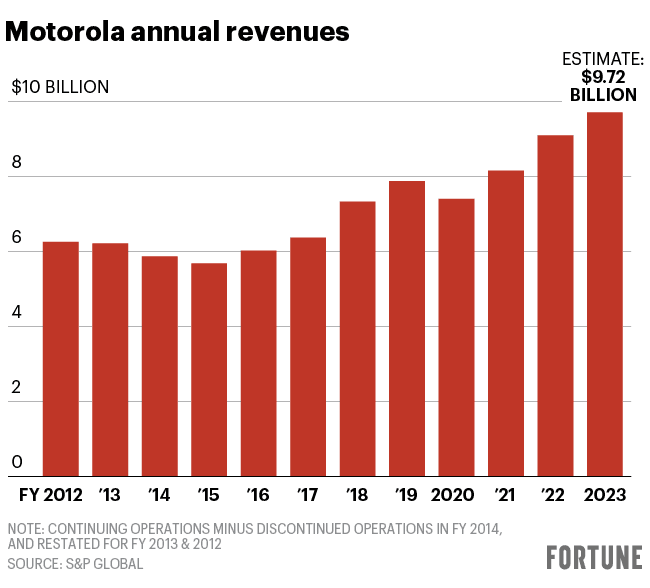
- Tariff volatility remains a core concern for Motorola Solutions; rising material costs are projected to pressure margins.
- The backlog dropped from $14.7 billion to $14.1 billion in Q1, showing some future revenue risk if orders slow.
- Integration of major acquisitions like Silvus ($4.4 billion) and earlier buys introduces execution risk.
- Competition in public safety comms from Airbus, Hytera (though legal wins), and Harris remains intense.
- Motorola Mobility is still small in the premium handset space versus Apple and Samsung, limiting brand presence.
- Reliance on Latin America and India for Moto volumes poses a risk if economic or policy shifts occur.
- Lack of presence in China means missing major smartphone growth regions, noted in the Motorola Statistics context.
- Software update delays historically have hurt user trust in Moto’s past launches.
- Economic slowdown or government budget cuts could impact enterprise orders, especially in public safety.
- Stock remains below key moving averages, and the RS rating is still below the top threshold, indicating stock performance risk.
| Risk Category | Description |
| Tariff & supply chain | Cost volatility affecting margins |
| Backlog decline | Future revenue under pressure |
| Acquisition integration | Execution risk from mergers like Silvus |
| Competitive environment | Strong rivals in enterprise comms |
Conclusion
Right, so that’s pretty much the big picture when it comes to Motorola Statistics. I know it’s a lot of numbers, but every stat we looked at says something real about the brand, where it came from, where it stands, and where it could be heading next. From their early radio days to now, making budget-friendly smartphones and public safety gear, Motorola’s journey is kinda wild if you think about it.
What I found interesting is how Motorola still manages to survive in a market where brands come and go so fast. Like, it’s not on top like it once was, but it’s also not irrelevant. That balance is what makes the data worth looking at. It’s not just about phones anymore; the company has smartly spread out into different segments.
So yeah, these Motorola Statistics are proof that even old giants can stay in the game if they know how to shift and evolve. Hope you got a better view of how Motorola’s been doing all these years. If you have any questions, kindly let me know in the comments section.
Sources
FAQ.
Motorola was founded in 1928, which makes the brand nearly 100 years old. It started off as a small company making car radios in Chicago.
Yeah, it’s still pretty active, especially in countries like India, Brazil, and the U.S. It may not be in the top 3, but it’s holding its place in the mid-range and budget smartphone market.
As of 2025, Motorola holds around 3% of the global smartphone market, with bigger shares in countries like Brazil (up to 20%) and the U.S. (around 6%).
Motorola Mobility, the smartphone division, is owned by Lenovo, which bought it from Google in 2014. The other part, Motorola Solutions, is a separate company focused on public safety tech.
Motorola Solutions has around 20,000 employees worldwide, while Motorola Mobility (under Lenovo) has a much smaller, integrated team within Lenovo’s mobile business unit.
In 2024, Motorola Solutions generated over $10.1 billion in revenue, mainly from communications products and software. Motorola Mobility’s revenue is clubbed under Lenovo’s mobile segment, which earned about $11.7 billion.
Motorola also produces two-way radios, public safety software, body cameras, and network infrastructure equipment, especially for police, fire, and emergency services.
Yes, somewhat. With the Motorola Edge and Razr foldables, they’ve re-entered the premium zone, but the success varies by region.
The Moto G series continues to be Motorola’s most popular line. The Moto G Power (2022) and Moto G Stylus (2023) did especially well in North America.
Motorola is doubling down on AI-driven features, 5G rollouts, and public safety solutions. They are also working on making their foldables more affordable to stay in the game.

I hold an MBA in Finance and Marketing, bringing a unique blend of business acumen and creative communication skills. With experience as a content in crafting statistical and research-backed content across multiple domains, including education, technology, product reviews, and company website analytics, I specialize in producing engaging, informative, and SEO-optimized content tailored to diverse audiences. My work bridges technical accuracy with compelling storytelling, helping brands educate, inform, and connect with their target markets.
